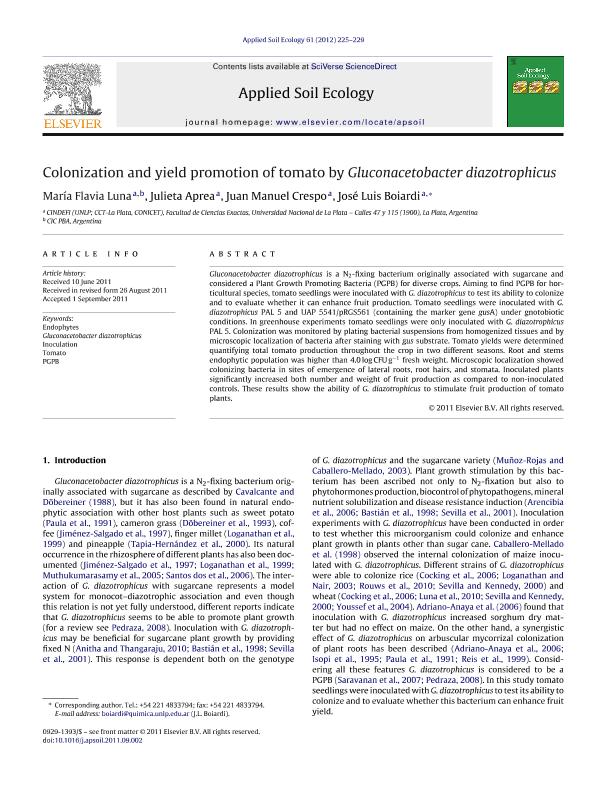Artículo
Colonization and yield promotion of tomato by Gluconacetobacter diazotrophicus
Fecha de publicación:
10/2012
Editorial:
Elsevier Science
Revista:
Applied Soil Ecology
ISSN:
0929-1393
Idioma:
Inglés
Tipo de recurso:
Artículo publicado
Clasificación temática:
Resumen
Gluconacetobacter diazotrophicus is a N 2-fixing bacterium originally associated with sugarcane and considered a Plant Growth Promoting Bacteria (PGPB) for diverse crops. Aiming to find PGPB for horticultural species, tomato seedlings were inoculated with G. diazotrophicus to test its ability to colonize and to evaluate whether it can enhance fruit production. Tomato seedlings were inoculated with G. diazotrophicus PAL 5 and UAP 5541/pRGS561 (containing the marker gene gusA) under gnotobiotic conditions. In greenhouse experiments tomato seedlings were only inoculated with G. diazotrophicus PAL 5. Colonization was monitored by plating bacterial suspensions from homogenized tissues and by microscopic localization of bacteria after staining with gus substrate. Tomato yields were determined quantifying total tomato production throughout the crop in two different seasons. Root and stems endophytic population was higher than 4.0logCFUg -1 fresh weight. Microscopic localization showed colonizing bacteria in sites of emergence of lateral roots, root hairs, and stomata. Inoculated plants significantly increased both number and weight of fruit production as compared to non-inoculated controls. These results show the ability of G. diazotrophicus to stimulate fruit production of tomato plants.
Palabras clave:
Endophytes
,
Gluconacetobacter Diazotrophicus
,
Inoculation
,
Pgpb
,
Tomato
Archivos asociados
Licencia
Identificadores
Colecciones
Articulos(CINDEFI)
Articulos de CENT.DE INV EN FERMENTACIONES INDUSTRIALES (I)
Articulos de CENT.DE INV EN FERMENTACIONES INDUSTRIALES (I)
Citación
Luna, Maria Flavia; Aprea, Julieta; Crespo, Juan Manuel; Boiardi, Jose Luis; Colonization and yield promotion of tomato by Gluconacetobacter diazotrophicus; Elsevier Science; Applied Soil Ecology; 61; 10-2012; 225-229
Compartir
Altmétricas




